IAS Exposure Draft and Public Interest
VerifiedAdded on 2020/11/23
|6
|1562
|219
Report
AI Summary
The assignment analyzes an International Accounting Standards Board (IASB) exposure draft, focusing on proposed changes to property and accounting policies. It discusses three key theories: private interest, public interest, and capture theory, highlighting how they relate to the IASB's objectives and the potential impact of the exposure draft on stakeholders. The analysis emphasizes the importance of the public interest theory in promoting the welfare of society as a whole.
Contribute Materials
Your contribution can guide someone’s learning journey. Share your
documents today.
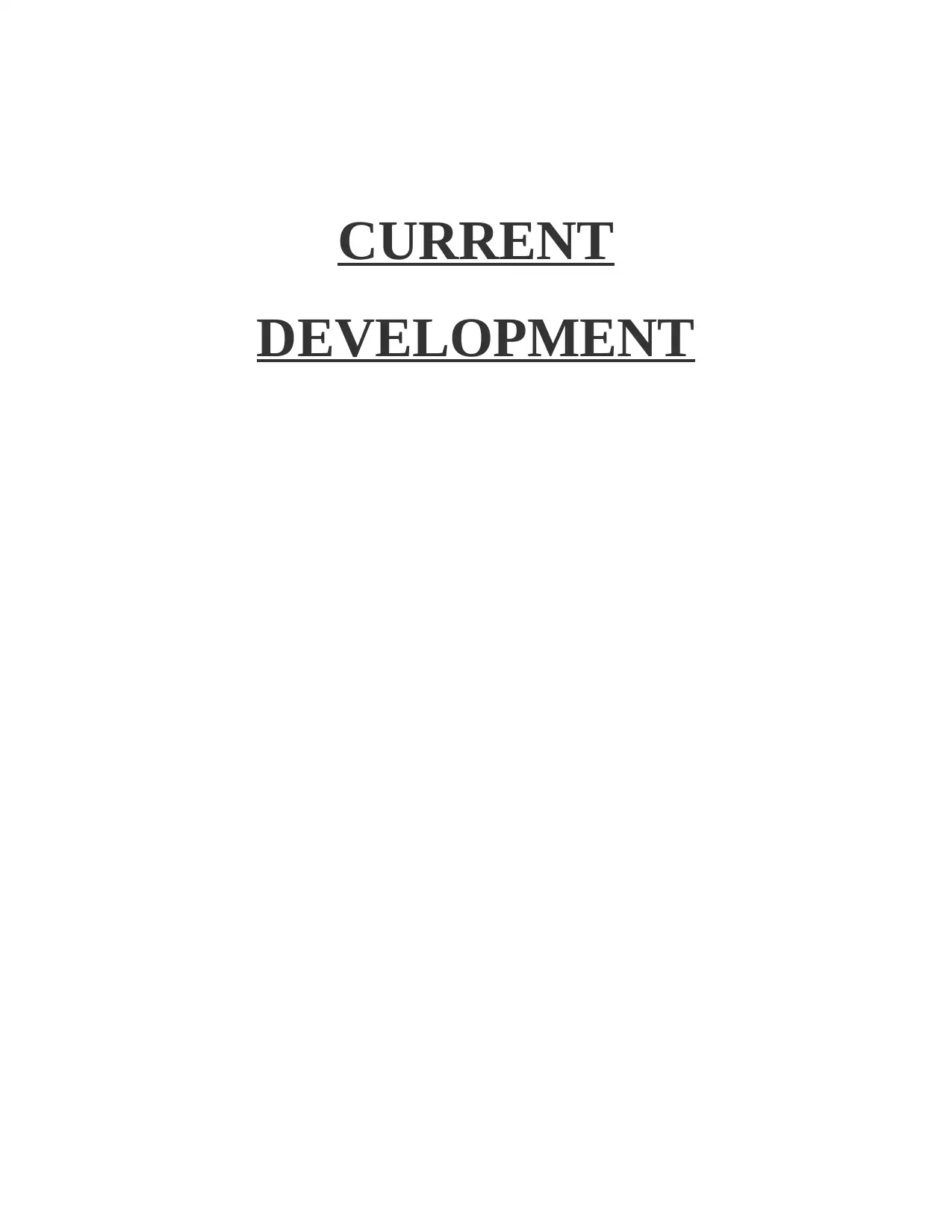
CURRENT
DEVELOPMENT
DEVELOPMENT
Secure Best Marks with AI Grader
Need help grading? Try our AI Grader for instant feedback on your assignments.
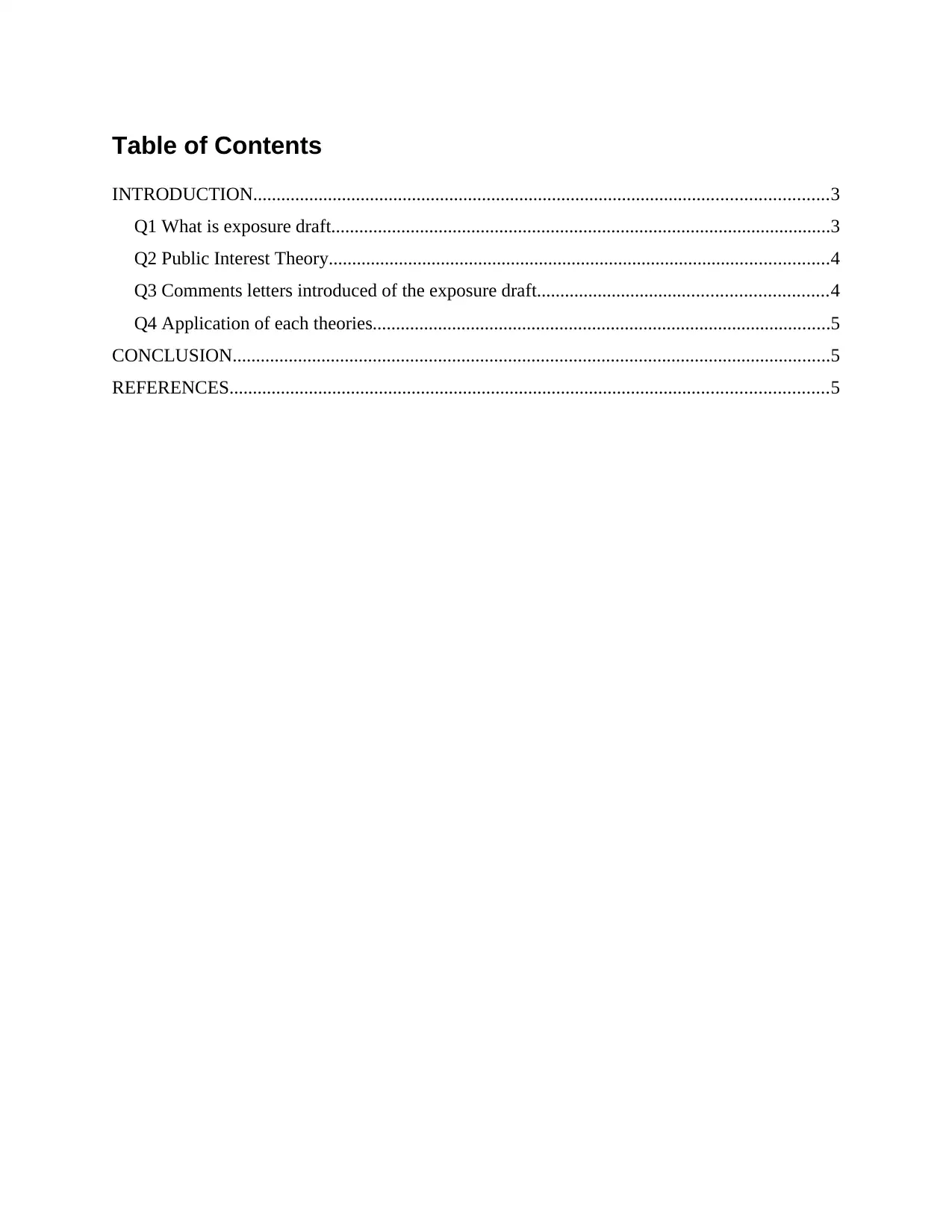
Table of Contents
INTRODUCTION...........................................................................................................................3
Q1 What is exposure draft...........................................................................................................3
Q2 Public Interest Theory...........................................................................................................4
Q3 Comments letters introduced of the exposure draft..............................................................4
Q4 Application of each theories..................................................................................................5
CONCLUSION................................................................................................................................5
REFERENCES................................................................................................................................5
INTRODUCTION...........................................................................................................................3
Q1 What is exposure draft...........................................................................................................3
Q2 Public Interest Theory...........................................................................................................4
Q3 Comments letters introduced of the exposure draft..............................................................4
Q4 Application of each theories..................................................................................................5
CONCLUSION................................................................................................................................5
REFERENCES................................................................................................................................5
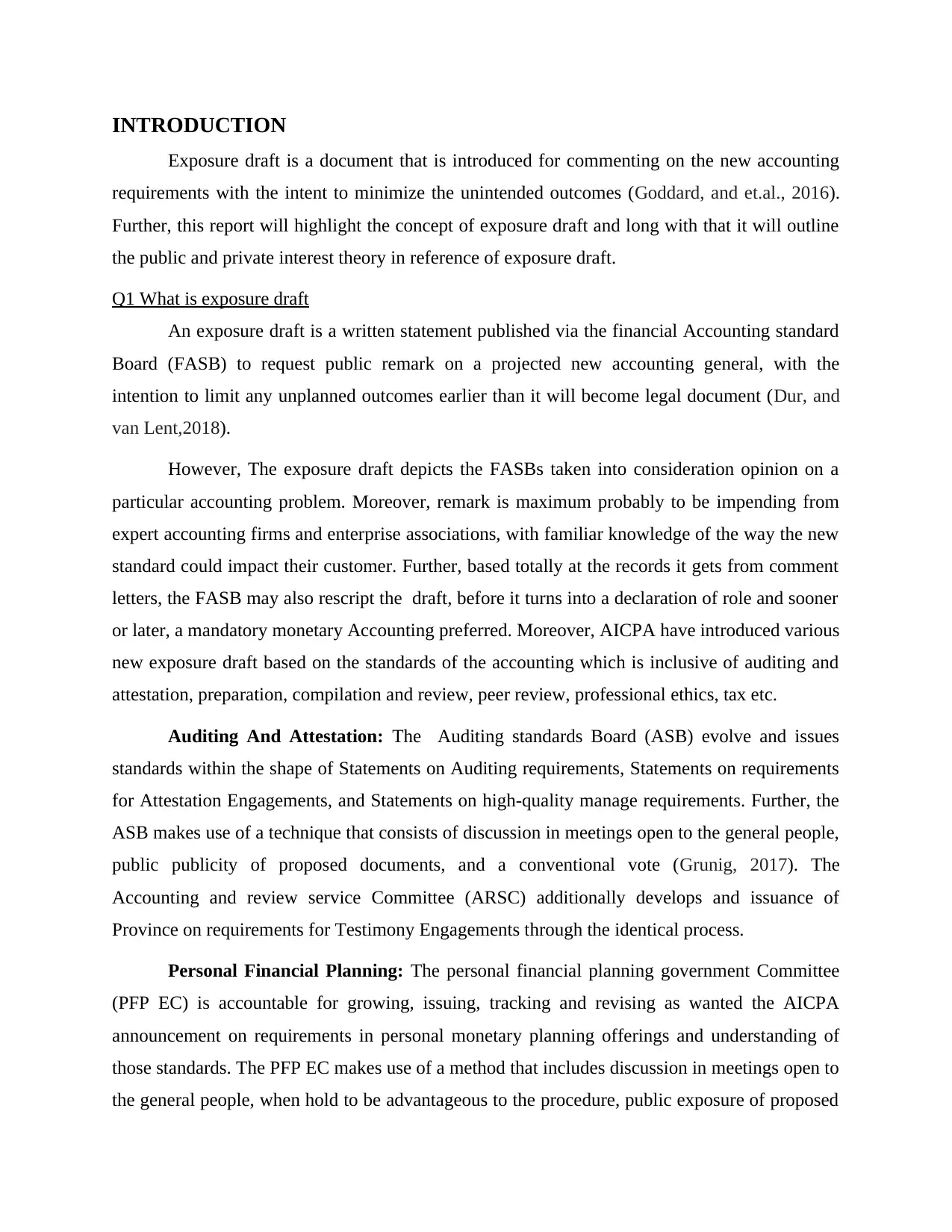
INTRODUCTION
Exposure draft is a document that is introduced for commenting on the new accounting
requirements with the intent to minimize the unintended outcomes (Goddard, and et.al., 2016).
Further, this report will highlight the concept of exposure draft and long with that it will outline
the public and private interest theory in reference of exposure draft.
Q1 What is exposure draft
An exposure draft is a written statement published via the financial Accounting standard
Board (FASB) to request public remark on a projected new accounting general, with the
intention to limit any unplanned outcomes earlier than it will become legal document (Dur, and
van Lent,2018).
However, The exposure draft depicts the FASBs taken into consideration opinion on a
particular accounting problem. Moreover, remark is maximum probably to be impending from
expert accounting firms and enterprise associations, with familiar knowledge of the way the new
standard could impact their customer. Further, based totally at the records it gets from comment
letters, the FASB may also rescript the draft, before it turns into a declaration of role and sooner
or later, a mandatory monetary Accounting preferred. Moreover, AICPA have introduced various
new exposure draft based on the standards of the accounting which is inclusive of auditing and
attestation, preparation, compilation and review, peer review, professional ethics, tax etc.
Auditing And Attestation: The Auditing standards Board (ASB) evolve and issues
standards within the shape of Statements on Auditing requirements, Statements on requirements
for Attestation Engagements, and Statements on high-quality manage requirements. Further, the
ASB makes use of a technique that consists of discussion in meetings open to the general people,
public publicity of proposed documents, and a conventional vote (Grunig, 2017). The
Accounting and review service Committee (ARSC) additionally develops and issuance of
Province on requirements for Testimony Engagements through the identical process.
Personal Financial Planning: The personal financial planning government Committee
(PFP EC) is accountable for growing, issuing, tracking and revising as wanted the AICPA
announcement on requirements in personal monetary planning offerings and understanding of
those standards. The PFP EC makes use of a method that includes discussion in meetings open to
the general people, when hold to be advantageous to the procedure, public exposure of proposed
Exposure draft is a document that is introduced for commenting on the new accounting
requirements with the intent to minimize the unintended outcomes (Goddard, and et.al., 2016).
Further, this report will highlight the concept of exposure draft and long with that it will outline
the public and private interest theory in reference of exposure draft.
Q1 What is exposure draft
An exposure draft is a written statement published via the financial Accounting standard
Board (FASB) to request public remark on a projected new accounting general, with the
intention to limit any unplanned outcomes earlier than it will become legal document (Dur, and
van Lent,2018).
However, The exposure draft depicts the FASBs taken into consideration opinion on a
particular accounting problem. Moreover, remark is maximum probably to be impending from
expert accounting firms and enterprise associations, with familiar knowledge of the way the new
standard could impact their customer. Further, based totally at the records it gets from comment
letters, the FASB may also rescript the draft, before it turns into a declaration of role and sooner
or later, a mandatory monetary Accounting preferred. Moreover, AICPA have introduced various
new exposure draft based on the standards of the accounting which is inclusive of auditing and
attestation, preparation, compilation and review, peer review, professional ethics, tax etc.
Auditing And Attestation: The Auditing standards Board (ASB) evolve and issues
standards within the shape of Statements on Auditing requirements, Statements on requirements
for Attestation Engagements, and Statements on high-quality manage requirements. Further, the
ASB makes use of a technique that consists of discussion in meetings open to the general people,
public publicity of proposed documents, and a conventional vote (Grunig, 2017). The
Accounting and review service Committee (ARSC) additionally develops and issuance of
Province on requirements for Testimony Engagements through the identical process.
Personal Financial Planning: The personal financial planning government Committee
(PFP EC) is accountable for growing, issuing, tracking and revising as wanted the AICPA
announcement on requirements in personal monetary planning offerings and understanding of
those standards. The PFP EC makes use of a method that includes discussion in meetings open to
the general people, when hold to be advantageous to the procedure, public exposure of proposed
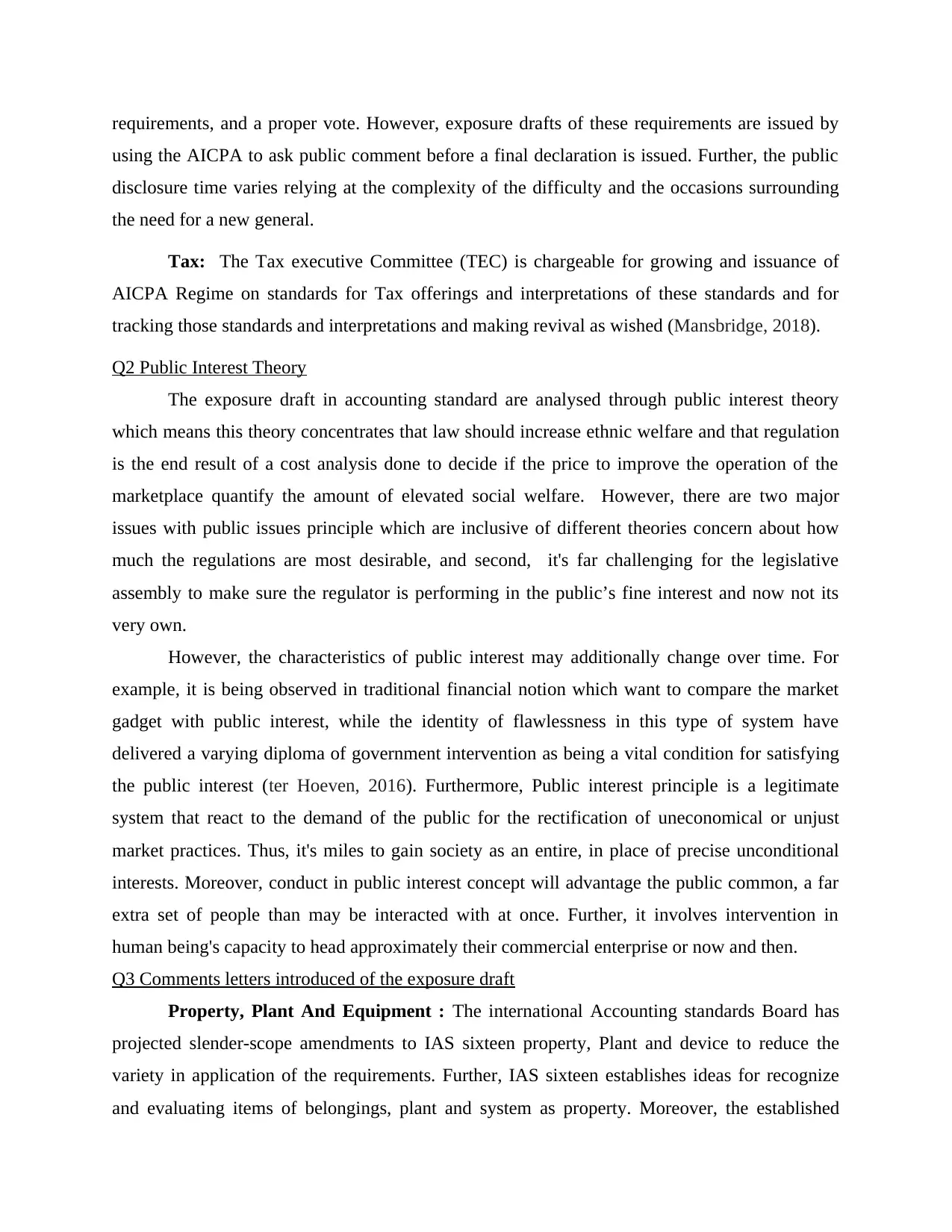
requirements, and a proper vote. However, exposure drafts of these requirements are issued by
using the AICPA to ask public comment before a final declaration is issued. Further, the public
disclosure time varies relying at the complexity of the difficulty and the occasions surrounding
the need for a new general.
Tax: The Tax executive Committee (TEC) is chargeable for growing and issuance of
AICPA Regime on standards for Tax offerings and interpretations of these standards and for
tracking those standards and interpretations and making revival as wished (Mansbridge, 2018).
Q2 Public Interest Theory
The exposure draft in accounting standard are analysed through public interest theory
which means this theory concentrates that law should increase ethnic welfare and that regulation
is the end result of a cost analysis done to decide if the price to improve the operation of the
marketplace quantify the amount of elevated social welfare. However, there are two major
issues with public issues principle which are inclusive of different theories concern about how
much the regulations are most desirable, and second, it's far challenging for the legislative
assembly to make sure the regulator is performing in the public’s fine interest and now not its
very own.
However, the characteristics of public interest may additionally change over time. For
example, it is being observed in traditional financial notion which want to compare the market
gadget with public interest, while the identity of flawlessness in this type of system have
delivered a varying diploma of government intervention as being a vital condition for satisfying
the public interest (ter Hoeven, 2016). Furthermore, Public interest principle is a legitimate
system that react to the demand of the public for the rectification of uneconomical or unjust
market practices. Thus, it's miles to gain society as an entire, in place of precise unconditional
interests. Moreover, conduct in public interest concept will advantage the public common, a far
extra set of people than may be interacted with at once. Further, it involves intervention in
human being's capacity to head approximately their commercial enterprise or now and then.
Q3 Comments letters introduced of the exposure draft
Property, Plant And Equipment : The international Accounting standards Board has
projected slender-scope amendments to IAS sixteen property, Plant and device to reduce the
variety in application of the requirements. Further, IAS sixteen establishes ideas for recognize
and evaluating items of belongings, plant and system as property. Moreover, the established
using the AICPA to ask public comment before a final declaration is issued. Further, the public
disclosure time varies relying at the complexity of the difficulty and the occasions surrounding
the need for a new general.
Tax: The Tax executive Committee (TEC) is chargeable for growing and issuance of
AICPA Regime on standards for Tax offerings and interpretations of these standards and for
tracking those standards and interpretations and making revival as wished (Mansbridge, 2018).
Q2 Public Interest Theory
The exposure draft in accounting standard are analysed through public interest theory
which means this theory concentrates that law should increase ethnic welfare and that regulation
is the end result of a cost analysis done to decide if the price to improve the operation of the
marketplace quantify the amount of elevated social welfare. However, there are two major
issues with public issues principle which are inclusive of different theories concern about how
much the regulations are most desirable, and second, it's far challenging for the legislative
assembly to make sure the regulator is performing in the public’s fine interest and now not its
very own.
However, the characteristics of public interest may additionally change over time. For
example, it is being observed in traditional financial notion which want to compare the market
gadget with public interest, while the identity of flawlessness in this type of system have
delivered a varying diploma of government intervention as being a vital condition for satisfying
the public interest (ter Hoeven, 2016). Furthermore, Public interest principle is a legitimate
system that react to the demand of the public for the rectification of uneconomical or unjust
market practices. Thus, it's miles to gain society as an entire, in place of precise unconditional
interests. Moreover, conduct in public interest concept will advantage the public common, a far
extra set of people than may be interacted with at once. Further, it involves intervention in
human being's capacity to head approximately their commercial enterprise or now and then.
Q3 Comments letters introduced of the exposure draft
Property, Plant And Equipment : The international Accounting standards Board has
projected slender-scope amendments to IAS sixteen property, Plant and device to reduce the
variety in application of the requirements. Further, IAS sixteen establishes ideas for recognize
and evaluating items of belongings, plant and system as property. Moreover, the established
Secure Best Marks with AI Grader
Need help grading? Try our AI Grader for instant feedback on your assignments.
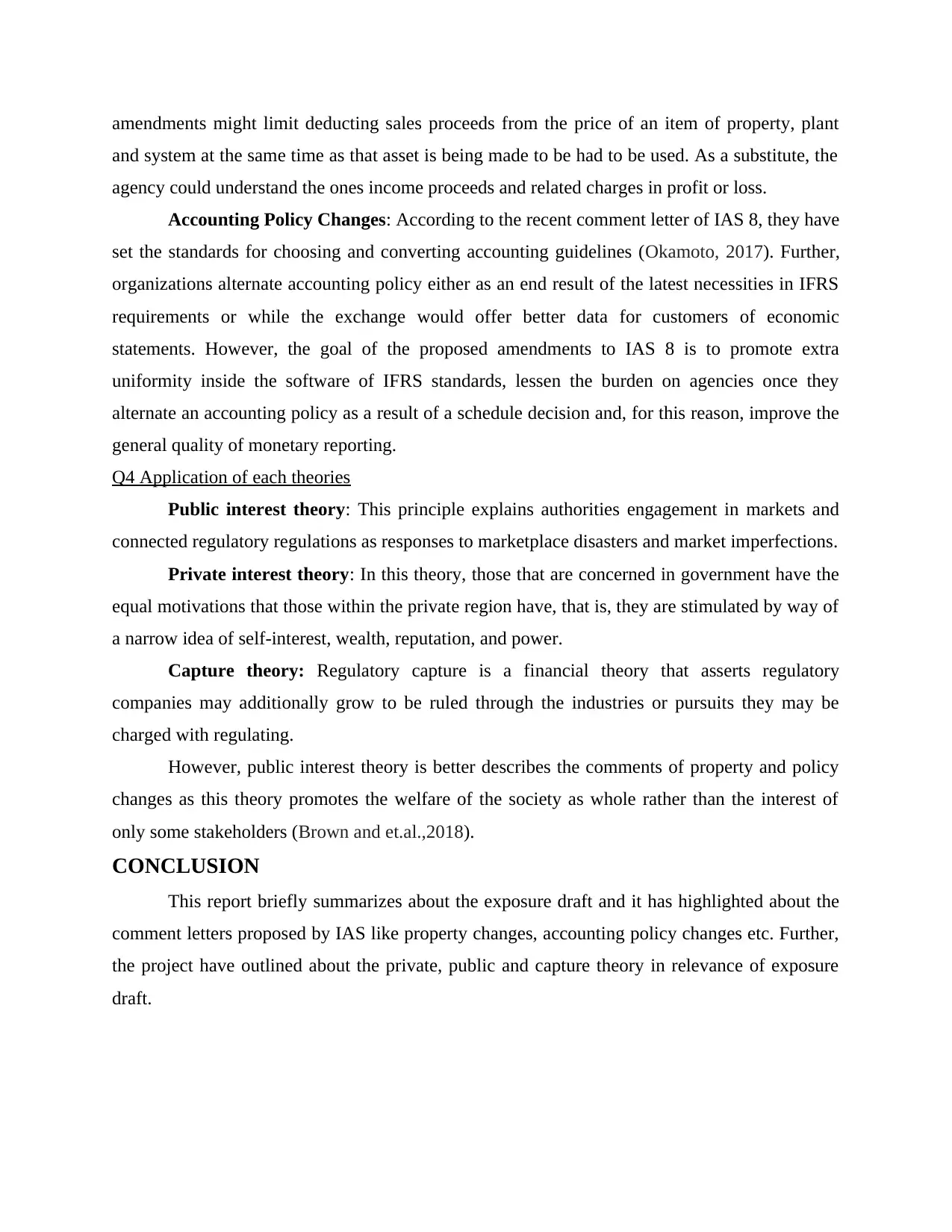
amendments might limit deducting sales proceeds from the price of an item of property, plant
and system at the same time as that asset is being made to be had to be used. As a substitute, the
agency could understand the ones income proceeds and related charges in profit or loss.
Accounting Policy Changes: According to the recent comment letter of IAS 8, they have
set the standards for choosing and converting accounting guidelines (Okamoto, 2017). Further,
organizations alternate accounting policy either as an end result of the latest necessities in IFRS
requirements or while the exchange would offer better data for customers of economic
statements. However, the goal of the proposed amendments to IAS 8 is to promote extra
uniformity inside the software of IFRS standards, lessen the burden on agencies once they
alternate an accounting policy as a result of a schedule decision and, for this reason, improve the
general quality of monetary reporting.
Q4 Application of each theories
Public interest theory: This principle explains authorities engagement in markets and
connected regulatory regulations as responses to marketplace disasters and market imperfections.
Private interest theory: In this theory, those that are concerned in government have the
equal motivations that those within the private region have, that is, they are stimulated by way of
a narrow idea of self-interest, wealth, reputation, and power.
Capture theory: Regulatory capture is a financial theory that asserts regulatory
companies may additionally grow to be ruled through the industries or pursuits they may be
charged with regulating.
However, public interest theory is better describes the comments of property and policy
changes as this theory promotes the welfare of the society as whole rather than the interest of
only some stakeholders (Brown and et.al.,2018).
CONCLUSION
This report briefly summarizes about the exposure draft and it has highlighted about the
comment letters proposed by IAS like property changes, accounting policy changes etc. Further,
the project have outlined about the private, public and capture theory in relevance of exposure
draft.
and system at the same time as that asset is being made to be had to be used. As a substitute, the
agency could understand the ones income proceeds and related charges in profit or loss.
Accounting Policy Changes: According to the recent comment letter of IAS 8, they have
set the standards for choosing and converting accounting guidelines (Okamoto, 2017). Further,
organizations alternate accounting policy either as an end result of the latest necessities in IFRS
requirements or while the exchange would offer better data for customers of economic
statements. However, the goal of the proposed amendments to IAS 8 is to promote extra
uniformity inside the software of IFRS standards, lessen the burden on agencies once they
alternate an accounting policy as a result of a schedule decision and, for this reason, improve the
general quality of monetary reporting.
Q4 Application of each theories
Public interest theory: This principle explains authorities engagement in markets and
connected regulatory regulations as responses to marketplace disasters and market imperfections.
Private interest theory: In this theory, those that are concerned in government have the
equal motivations that those within the private region have, that is, they are stimulated by way of
a narrow idea of self-interest, wealth, reputation, and power.
Capture theory: Regulatory capture is a financial theory that asserts regulatory
companies may additionally grow to be ruled through the industries or pursuits they may be
charged with regulating.
However, public interest theory is better describes the comments of property and policy
changes as this theory promotes the welfare of the society as whole rather than the interest of
only some stakeholders (Brown and et.al.,2018).
CONCLUSION
This report briefly summarizes about the exposure draft and it has highlighted about the
comment letters proposed by IAS like property changes, accounting policy changes etc. Further,
the project have outlined about the private, public and capture theory in relevance of exposure
draft.
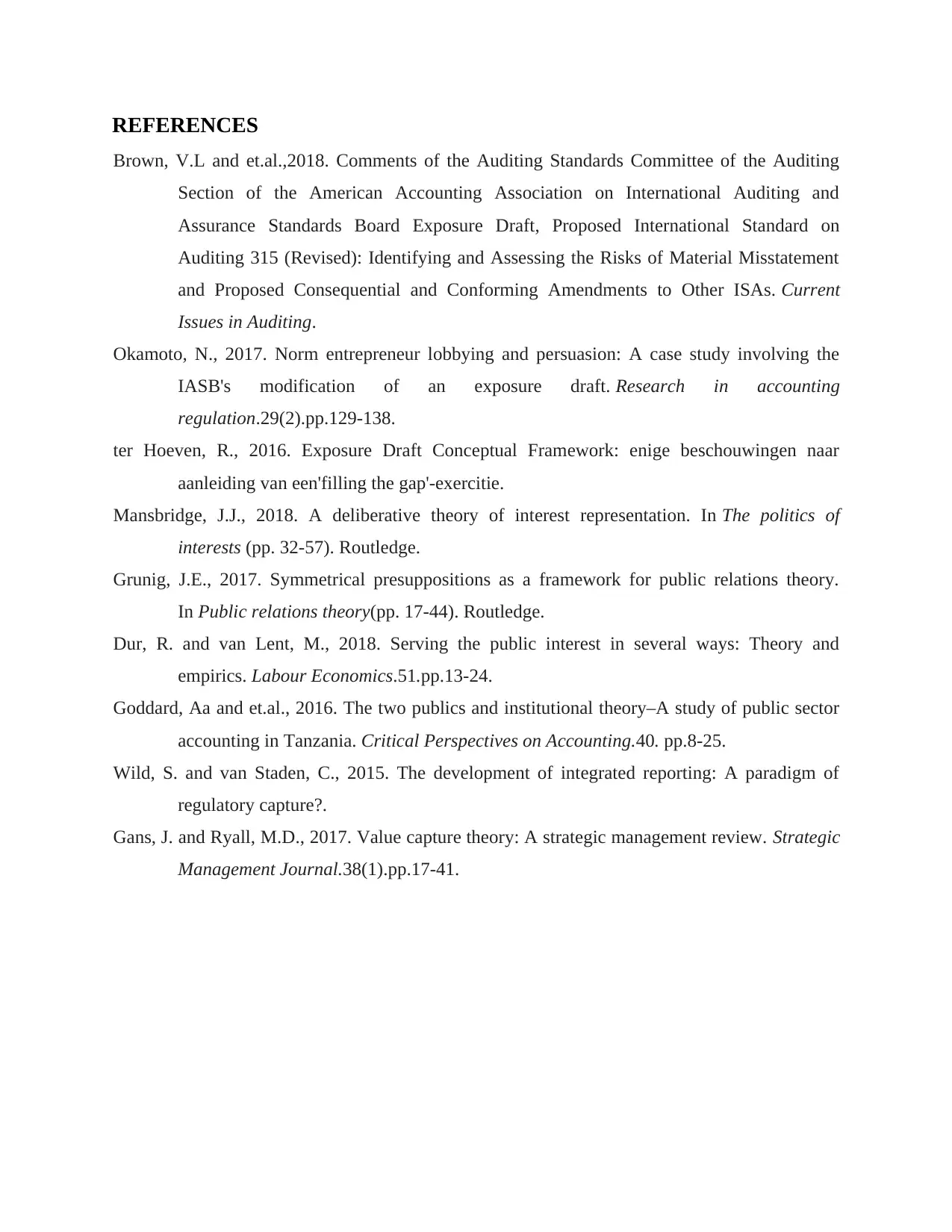
REFERENCES
Brown, V.L and et.al.,2018. Comments of the Auditing Standards Committee of the Auditing
Section of the American Accounting Association on International Auditing and
Assurance Standards Board Exposure Draft, Proposed International Standard on
Auditing 315 (Revised): Identifying and Assessing the Risks of Material Misstatement
and Proposed Consequential and Conforming Amendments to Other ISAs. Current
Issues in Auditing.
Okamoto, N., 2017. Norm entrepreneur lobbying and persuasion: A case study involving the
IASB's modification of an exposure draft. Research in accounting
regulation.29(2).pp.129-138.
ter Hoeven, R., 2016. Exposure Draft Conceptual Framework: enige beschouwingen naar
aanleiding van een'filling the gap'-exercitie.
Mansbridge, J.J., 2018. A deliberative theory of interest representation. In The politics of
interests (pp. 32-57). Routledge.
Grunig, J.E., 2017. Symmetrical presuppositions as a framework for public relations theory.
In Public relations theory(pp. 17-44). Routledge.
Dur, R. and van Lent, M., 2018. Serving the public interest in several ways: Theory and
empirics. Labour Economics.51.pp.13-24.
Goddard, Aa and et.al., 2016. The two publics and institutional theory–A study of public sector
accounting in Tanzania. Critical Perspectives on Accounting.40. pp.8-25.
Wild, S. and van Staden, C., 2015. The development of integrated reporting: A paradigm of
regulatory capture?.
Gans, J. and Ryall, M.D., 2017. Value capture theory: A strategic management review. Strategic
Management Journal.38(1).pp.17-41.
Brown, V.L and et.al.,2018. Comments of the Auditing Standards Committee of the Auditing
Section of the American Accounting Association on International Auditing and
Assurance Standards Board Exposure Draft, Proposed International Standard on
Auditing 315 (Revised): Identifying and Assessing the Risks of Material Misstatement
and Proposed Consequential and Conforming Amendments to Other ISAs. Current
Issues in Auditing.
Okamoto, N., 2017. Norm entrepreneur lobbying and persuasion: A case study involving the
IASB's modification of an exposure draft. Research in accounting
regulation.29(2).pp.129-138.
ter Hoeven, R., 2016. Exposure Draft Conceptual Framework: enige beschouwingen naar
aanleiding van een'filling the gap'-exercitie.
Mansbridge, J.J., 2018. A deliberative theory of interest representation. In The politics of
interests (pp. 32-57). Routledge.
Grunig, J.E., 2017. Symmetrical presuppositions as a framework for public relations theory.
In Public relations theory(pp. 17-44). Routledge.
Dur, R. and van Lent, M., 2018. Serving the public interest in several ways: Theory and
empirics. Labour Economics.51.pp.13-24.
Goddard, Aa and et.al., 2016. The two publics and institutional theory–A study of public sector
accounting in Tanzania. Critical Perspectives on Accounting.40. pp.8-25.
Wild, S. and van Staden, C., 2015. The development of integrated reporting: A paradigm of
regulatory capture?.
Gans, J. and Ryall, M.D., 2017. Value capture theory: A strategic management review. Strategic
Management Journal.38(1).pp.17-41.
1 out of 6
Your All-in-One AI-Powered Toolkit for Academic Success.
+13062052269
info@desklib.com
Available 24*7 on WhatsApp / Email
![[object Object]](/_next/static/media/star-bottom.7253800d.svg)
Unlock your academic potential
© 2024 | Zucol Services PVT LTD | All rights reserved.